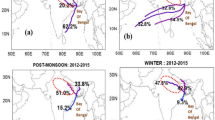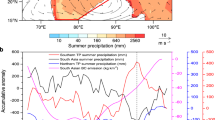Abstract
The influence of local black carbon (BC) on monthly mean precipitation and the associated circulation in South Asia is investigated. The results show that the amplified shortwave radiative heating rate by BC absorption enhances convective activity near the Himalayas and the southern Tibetan Plateau with increased rainfall anomalies in April and May, which is consistent with previous studies. However, the enhanced vertical motions and the precipitation ultimately lead towards cooling of the lower troposphere especially in May, which is extended till June. This favored negative rainfall responses in June, implying delay in the onset of South Asian summer monsoon rainfalls over Arabian Sea and western parts of the subcontinent. The negative precipitation response is further associated with the prevailing anomalous high pressure and the anticyclonic wind circulations induced by BC. Thus, we present here one different feature associated with BC-induced elevated heat pump-like circulations in South Asia.







Similar content being viewed by others
References
Auffhammer M, Ramanathan V, Vincent JR (2006) Integrated model shows that atmospheric brown clouds and greenhouse gases have reduced rice harvests in India. Proc Natl Acad Sci USA 103:19668–19672
Bollasina MA, Ming Y, Ramaswamy V (2011) Anthropogenic aerosols and the weakening of the south Asian summer monsoon. Science 334:502–505
GFDL Global Atmospheric Model Development Team (GAMDT) (2004) The new global atmosphere and land model AM2-LM2: evaluation with prescribed SST simulations. J Clim 17:4641–4673
Ginoux PA, Horowitz LW, Ramaswamy V, Geogdzhayev IV, Holben BN, Stenchikov G, Tie X (2006) Evaluation of aerosol distribution and optical depth in the Geophysical Fluid Dynamics Laboratory coupled model CM2.1 for present climate. J Geophys Res 111:D22210. doi:10.1029/2005JD006707
Haywood JM, Ramaswamy V, Soden BJ (1999) Tropospheric aerosol climate forcing in clear-sky satellite observations over the oceans. Science 283:1299–1303
Horowitz LW (2006) Past, present, and future concentrations of tropospheric ozone and aerosols: methodology, ozone evaluation, and sensitivity to aerosol wet removal. J Geophys Res 111:D22211. doi:10.1029/2005JD006937
Horowitz LW, Walters S, Mauzerall DL et al (2003) A global simulation of tropospheric ozone and related tracers: description and evaluation of MOZART, version 2. J Geophys Res 108(D24):4784. doi:10.1029/2002JD002853
Jacobson MZ (2001) Strong radiative heating due to the mixing state of black carbon in atmospheric aerosols. Nature 409:695–698
Kumar KK, Kumar KR, Ashrit RG, Deshpande NR, Hansen JW (2004) Climate impacts on Indian agriculture. Int J Climatol 24:1375–1393
Lau KM, Kim MK, Kim KM (2006) Asian summer monsoon anomalies induced by aerosol direct forcing: the role of the TP. Clim Dyn 26(7):855–864
Li C, Yanai M (1996) The onset and interannual variability of the Asian summer monsoon in relation to land–sea thermal contrast. J Climate 9:358–375
Mahmood R, Li S, Yao J-F (2010) Analysis of South Asian monsoons within the context of increasing regional black carbon aerosols. Atmos Oceanic Sci Lett 3:224–231
Meehl GA, Arblaster JM, Collins WD (2008) Effects of black carbon aerosols on the Indian monsoon. J Climate 21:2869–2882. doi:10.1175/2007JCLI1777.1
Menon S, Hansen J, Nazarenko L, Luo Y (2002) Climate effects of black carbon aerosols in China and India. Science 297:2250–2253
Ming Y, Ramaswamy V (2011) A model based investigation of aerosol-induced changes in tropical circulation. J Climate 24:5125–5133
Ming Y, Ramaswamy V, Chen G (2011) A model based investigation of aerosol-induced changes in boreal winter extratropical circulation. J Climate 24:6077–6091
Ramanathan V, Chung C, Kim D et al (2005) Atmospheric brown clouds: impact on South Asian climate and hydrologic cycle. Proc Natl Acad Sci USA 102:5326–5333. doi:10.1073/pnas.0500656102
Randles CA, Ramaswamy V (2008) Absorbing aerosols over Asia: a Geophysical Fluid Dynamics Laboratory general circulation model sensitivity study of model response to aerosol optical depth and aerosol absorption. J Geophys Res 113:D21203. doi:10.1029/2008JD010140
Sahu SK, Beig G, Sharma C (2008) Decadal growth of black carbon emissions in India. Geophys Res Lett 35:L02807. doi:10.1029/2007GL032333
Shindell D, Faluvegi G (2009) Climate response to regional radiative forcing during the twentieth century. Nat Geosci 2:294–300. doi:10.1038/ngeo473
Stier P, Seinfeld JH, Kinne S, Boucher O (2007) Aerosol absorption and radiative forcing. Atmos Chem Phys 7:5237–5261
Wang C, Kim D, Ekman AML, Barth MC, Rasch PJ (2009) Impact of anthropogenic aerosols on Indian summer monsoon. Geophys Res Lett 36:L21704. doi:10.1029/2009GL
Wu G, Zhang Y (1998) TP forcing and the timing of the monsoon onset over South Asia and the South China Sea. Mon Weather Rev 126:913–927
Wu J, Fu C, Xu Y, Tang JP, Wang W, Wang Z (2008) Simulation of direct effects of black carbon aerosol on temperature and hydrological cycle in Asia by a regional climate model. Meteorol Atmos Phys 100:179–193
Acknowledgments
The comments from anonymous reviewers and the editor are thankfully acknowledged, which led to an overall refinement of the manuscript. This study was supported by the Knowledge Innovation Program of the Chinese Academy of Sciences (grant no. KZCX2-YW-Q11-03).
Author information
Authors and Affiliations
Corresponding author
Rights and permissions
About this article
Cite this article
Mahmood, R., Li, S. Delay in the onset of South Asian summer monsoon induced by local black carbon in an AGCM. Theor Appl Climatol 111, 529–536 (2013). https://doi.org/10.1007/s00704-012-0681-3
Received:
Accepted:
Published:
Issue Date:
DOI: https://doi.org/10.1007/s00704-012-0681-3





